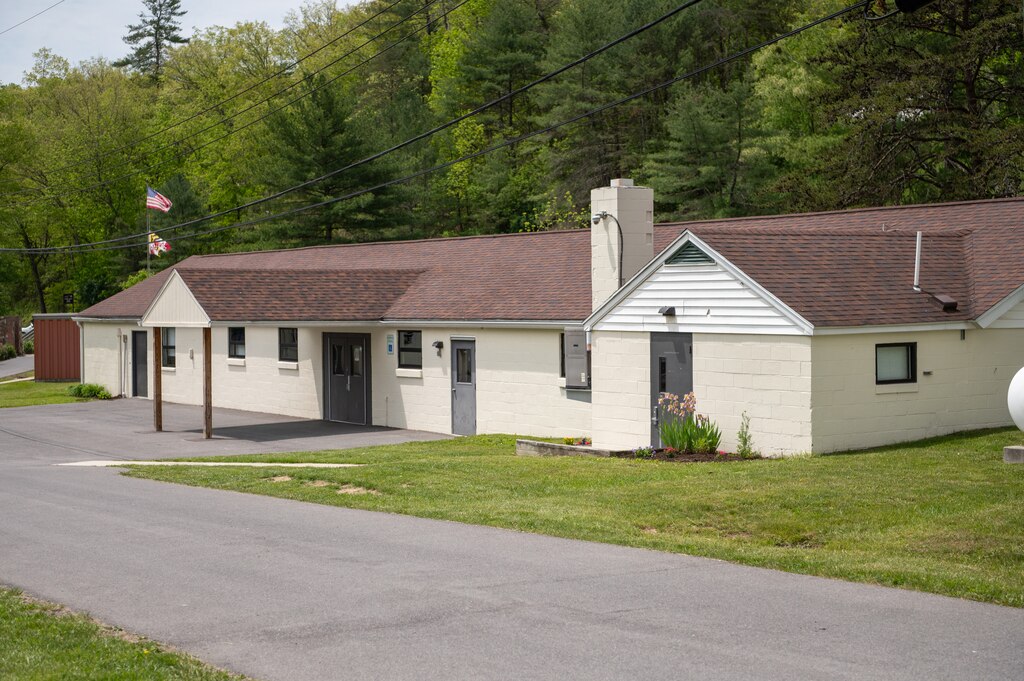Sheila Overstreet went back to work as a resident advisor for the Maryland Department of Juvenile Services at the end of April, more than two months after she‘d been sexually assaulted on the job by one of the teens she was supposed to supervise.
The 43-year-old Allegany County resident serves as one of about 60 front-line support staff at Green Ridge Youth Center responsible for monitoring youth who have been sent there by a judge. In January, she was working with a group of boys who repeatedly got out of control. Even with assistance from colleagues, the situation escalated until one of the boys allegedly touched Overstreet in a sexual manner.
Overstreet’s not alone.
About half of her colleagues are out on injured leave, according to union reps, and most because they have been injured by teens being treated at the remote Western Maryland facility.
The Baltimore Banner thanks its sponsors. Become one.
Overstreet said the problems escalated about six months before she was attacked and teens face few consequences when they assault staff.
“How are these boys supposed to be rehabilitated back into the community if they’re not being held accountable for their actions?” she asked. “How are we to hold them accountable when there‘s nothing to hold them accountable with?”
In her one-year at the facility, she‘s witnessed her colleagues kicked, punched in the face and spat on. Some have left work in an ambulance. Staff have reported, among other injuries, a concussion, a broken nose and eye socket.
Interviews conducted independently with Green Ridge resident advisors, a case manager, a social worker and reps from the American Federation of State, County and Municipal Employees, a union representing the majority of juvenile services workers, revealed the same, specific violent incidents. Some had personally witnessed altercations or had experienced violence themselves.
Most asked to have their names withheld because they still worked at Green Ridge or had moved on to new jobs and wanted to leave the experience behind.
The Baltimore Banner thanks its sponsors. Become one.
Staff said morale is at an all-time low. They’re frequently asked to cover extra shifts and, with little notice, travel to other facilities to help out.
There were dozens of assaults on staff at Green Ridge in 2024, double last year’s number, according to the state’s juvenile services watchdog. And so far this year, Maryland State Police have fielded dozens of calls for assaults at state youth facilities but those records don’t specify whether the assaults were youth on staff.
The state‘s watchdog, the Juvenile Justice Monitoring Unit, highlighted Green Ridge as an outlier in its 2024 annual report, saying it “continues to struggle with daily operations.” Many staff have just a few years experience and have insufficient training to work with incarcerated young people, the report said.
The use of physical restraints by staff to control outbursts is up in every juvenile services facility, but there were more than 400 at Green Ridge, double that of a neighboring facility with roughly the same capacity.
A social worker hired by the state with more than a dozen years of therapeutic experience, including treating children with serious behavioral issues, ended her contract three months early. No amount of money was worth her safety, she said. And if something had gone terribly wrong, she didn’t want to appear as though she’d cosigned the chaos.
The Baltimore Banner thanks its sponsors. Become one.
Workers at Green Ridge, she said, were “getting the shit beat out of them.”
With so many out on injured leave, those still working called out sick because they’re worried about safety and burned out staff were constantly in survival mode.
Staff are the safety net
There are no perimeter fences or locked cells at the facility. Children live, go to school and eat together in nondescript cement block buildings, which do lock. But the staff are their own security.

“We‘re all trying to go home the same way we came in,” said one mid-career resident advisor. But lately, he said it feels like “every man for himself.”
He’s worked at Green Ridge for more than 5 years, but he said it started to “feel different” just after Gov. Wes Moore took office. Working conditions have worsened under Juvenile Services Secretary Vincent Schiraldi, staff said, and promises to add more staff and implement changes have worn thin.
The Baltimore Banner thanks its sponsors. Become one.
The agency vacancy rate has dropped under the new administration but that number doesn’t reflect staff on injured or sick leave.
The resident advisor said he saw one colleague take more than a half-dozen blows to his face and head trying to restrain a teen. Restraints, or physical holds, are not uncommon, but are a last resort after other attempts at de-escalation fail.
“When I started, if a youth assaulted staff, it wasn’t a question, it wasn’t a debate,” he said. “A youth might have gotten away with one assault, but after that, you’re getting put on a van and you’re getting transferred out of there.”
But those consequences and others, like filing charges and adding time onto a youth’s stay for poor behavior, are no longer consistently used, he said. According to state data, so-called removals of youths dropped statewide by nearly half between July 2022 and June 2024.
Allowing the status quo, he said, sends a signal that violent behavior is tolerated and that staff “don’t matter — like anything can happen to us. We‘re a dime a dozen.”
The Baltimore Banner thanks its sponsors. Become one.
Schiraldi said he “takes assaults of staff — and any violence in our facilities whether it’s against staff or kids — very seriously,” not just as an agency head but as someone who has experienced assault as a former front-line youth worker.
Staff work in an environment “where there’s lots of troubled kids with lots of problems — one of which is violence, occasionally — and it’s our job to keep them safe,” he said, while at the same time helping them turn their lives around.
“Automatic expulsions and time freezes don’t get us there,” he said, advocating for consequences that include making amends, learning how to talk through conflict — and when necessary — sending a child back to detention.

The majority of teens arrested, charged, adjudicated and placed in juvenile services facilities in Maryland are Black and not from Western Maryland. Most are navigating a stressful life experience hours away from home with limited connection to family support systems.
First-hand experience
Schiraldi is a career criminal justice reformer who embraces evidence-based approaches to juvenile rehabilitation, which includes services, like therapy and mentoring, and proposes eliminating youth prisons in favor of smaller, home-like settings based in that child‘s community.
The Baltimore Banner thanks its sponsors. Become one.
Schiraldi has launched novel gun violence prevention programs, staff trainings and listening sessions with law enforcement around the state.

But his ideas have not always found favor with state’s attorneys seeking more say over juvenile cases and politicians facing public blowback over teen crime.
Schiraldi said changing a system takes time “and initially it’s scary” for everyone involved.
“But talking through problems with young people, de-escalation, cognitive behavioral therapy have been shown repeatedly to improve young people’s behavior and reduce violence in facilities like this,” he said.
Early in his career, Schiraldi was assaulted by a teenager in a New York youth facility. He was punched, kicked and thrown to the ground. Schiraldi was so angered he wanted the kid ejected. But his boss talked him out of it and taught him how he could‘ve handled the situation differently.
When the teen graduated the program, they were on good terms.
“He was better because of it, and I was better because of it,” he said.
Staff seeks tools
Staff say they agree with the intent of Maryland‘s approach and want kids to succeed but question how effective they can be when shifts are so understaffed.
Denise Henderson-Johnson, a juvenile services transportation officer, has worked with the agency for about two decades, including as a resident advisor and in supervisory roles. The president of the local workers’ union said she’s fielding five to 10 calls a week from colleagues across the state, telling her they’ve been assaulted by youth.
“I say every day to myself, ‘God, please don’t let me be one of the presidents that’s gotta stand at a podium and have a memorial service for one of my members,” she said, referencing the recent death of a Maryland parole and probation agent killed on the job. “I do not want to do that. Something has to be done.”
“You cannot go around putting your hands on people and not face a consequence,” she said. “We are not saying punish them, but they need to know there’s accountability for negative behavior.”
Hope for safety after assault
Female staff have been asking male staff to partner up for safety when the teens say or do inappropriate things. More than one woman has reported to union reps being groped or grabbed by youth.
The day Overstreet was sexually assaulted, the facility was fully staffed, by her count. She was in a rec room, where kids watch TV and participate in activities. But on this day, she found herself repeatedly redirecting three youths.
“They were just getting in my face. They were trying to get in my pockets. They just would not get out of my personal space whatsoever,” she said.
When things got beyond her control, she called for help, pushing the button on her ear piece.
“Staff assistance to front rec,” she called, multiple times.
Colleagues would come and help her calm things down. But the boys would kick up again. Then, things reached a chaotic level.
As she moved toward the door, a teen hovered close behind her and pressed his erection to her backside.
“You need to go!” she told him and recalled him responding with a lewd comment. She radioed for help and a male staff member was there within seconds.
The physical violation not only has traumatized Overstreet but caused her to lose confidence in the agency. She reported the incident to supervisors, but they were slow to search security footage until she pressed charges with Maryland State Police.
The teen, after learning she filed a report, charged at her, yelling and cursing.
“My anxiety got so bad,” she said. “I had chest pains to the point where I actually had to go to the doctor.”
She stayed out of work — without pay after her worker’s compensation claim was denied — for more than two months, too nervous to go back. A therapist diagnosed her with post-traumatic stress disorder. She‘s lost wages and had to pay out of pocket for her health insurance and therapy. Bills have piled up.
Overstreet said the agency should go back to what used to work and hopes plans to add staff and training happens soon.
But she knows she can make a difference.
On her dresser there’s a thick, gray rubber bracelet given to her by one teen as he left the program. The bracelets are given out to youth as encouragement. This one had the words “get the facts” written on the side.
When he handed it to her he said: “‘This will be my reminder that I‘m not going to end up back in here, and I‘m going to find a better way for myself.’”
Treatment can work, she said, but staff needs to be protected.



Comments
Welcome to The Banner's subscriber-only commenting community. Please review our community guidelines.